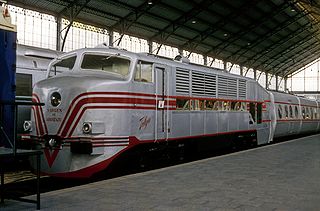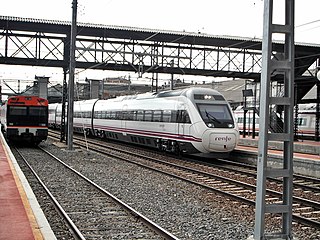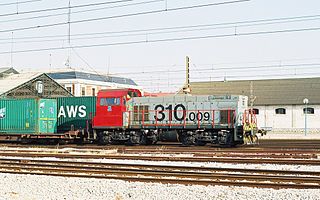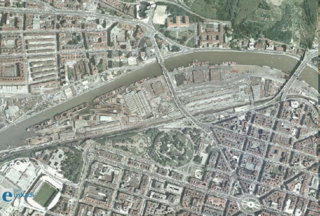
The commuter rail systems of Spain's major metropolitan areas are called Cercanías in most of Spain, Rodalia in the Valencian Community, Aldiriak in the Basque Country and Rodalies in Catalonia. There are twelve Cercanías systems in and around the cities of Asturias, Bilbao, Cádiz, Catalonia, Madrid, Málaga, Murcia/Alicante, Santander, San Sebastián, Seville, Valencia and Zaragoza. They are linked to Metro systems in Madrid, Barcelona, Bilbao and Valencia.

The Renfe 334 is a high speed, 4 axle diesel-electric locomotive built to haul passenger trains on Renfe's Talgo service on non electrified lines.

The Renfe Series 333 are high power six-axle diesel-electric locomotives built in the 1970s; at the time of their introduction they were the most powerful non-electric locomotives in Spain.

The Class 340 of Renfe were a class of 4-axle diesel-hydraulic locomotives built by Krauss-Maffei for the Spanish Railways. The design is similar in outward appearance and technology to the DB Class V 200. 32 units were built.
Stadler Rail Valencia SAU is a Spanish company, mainly producing products for the railway industry, subsidiary of Stadler Rail.

The Renfe Class 350 is a series of four single-cabin diesel locomotives that were delivered to Spain in 1950 for use with Talgo II coaches, being built in the United States by the American Car & Foundry to a distinctly American external style.

The Renfe Class 130 or S-130 is a high-speed dual-gauge, dual-voltage trainset consisting of 11 Talgo VII tilting coaches and two power cars, used on Alvia services. The class have been nicknamed patitos (ducklings), due to the shape of the train nose.

The Renfe Class 120 are electric multiple units used on Alvia high-speed rail services in Spain. Based on a family trains CAF Cepia.

The Renfe Class 252 are a series of Bo'Bo' electric locomotives, built by CAF, Meinfesa, Siemens and Krauss-Maffei for RENFE. 15 units were built for the AVE Madrid–Seville high speed line in, and 60 units constructed for general use to Iberian gauge (1668mm).

The Renfe classes 319.2, 319.3 and 319.4 are six axle Co'Co' medium power mainline diesel-electric locomotives manufactured by Macosa using General Motors Electromotive division components under license.

The 254 Series is a meter gauge freight diesel locomotive built for Ferrocarrils de la Generalitat de Catalunya (FGC).

The Renfe Class 319 was a class of mainline medium-high powered diesel electric locomotives built by General Motors Electro-Motive Division and by Macosa for the state railways of Spain.

The Renfe Class 309 is a class of 20 three axle diesel-hydraulic locomotives shunters built by M.T.M. for Renfe, and introduced between 1986-7.

The Renfe Class 310 is a class of 60 four axle Bo'Bo' diesel-electric locomotives for shunting and freight built by Meinfesa with General Motors Electromotive Division components.

The Renfe Class 311 is a class of four axle Bo'Bo' diesel electric shunting and light freight locomotives.

The ALCO RSD-39 was a six axle, low axle weight diesel-electric locomotive built by ALCO and under license by Euskalduna.

Trenhotel is a long distance, high-quality overnight train service which uses Talgo tilting trains technology and sleeping cars developed by the Spanish rail network operator Renfe. It is operated by Renfe when it operates within Spain, and is operated by its subsidiary Elipsos when in France, Switzerland and Italy.

The Série 1320 were a class of diesel locomotives used by Portuguese Railways (CP). All have now been withdrawn from service.

Euskalduna de Construcción y Reparación de Buques de Bilbao was an engineering company specialising in ship construction, later rail and road vehicles. The company was based in Bilbao, Spain and operated from 1900 until closure in 1984.

The Renfe Class 321 is a class of diesel-electric locomotives operated by Renfe in Spain, designed by Alco and built by them and by Euskalduna under licence.



















